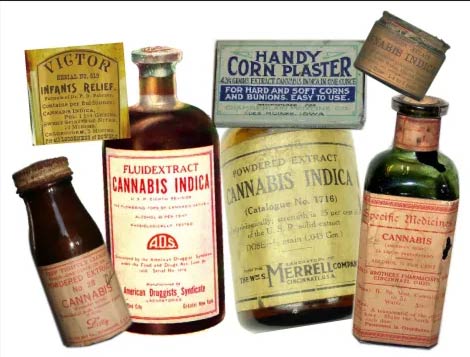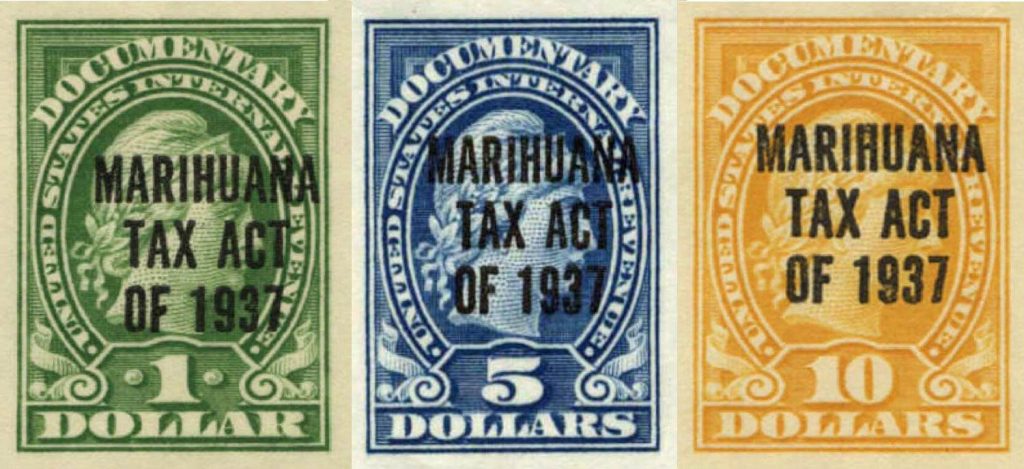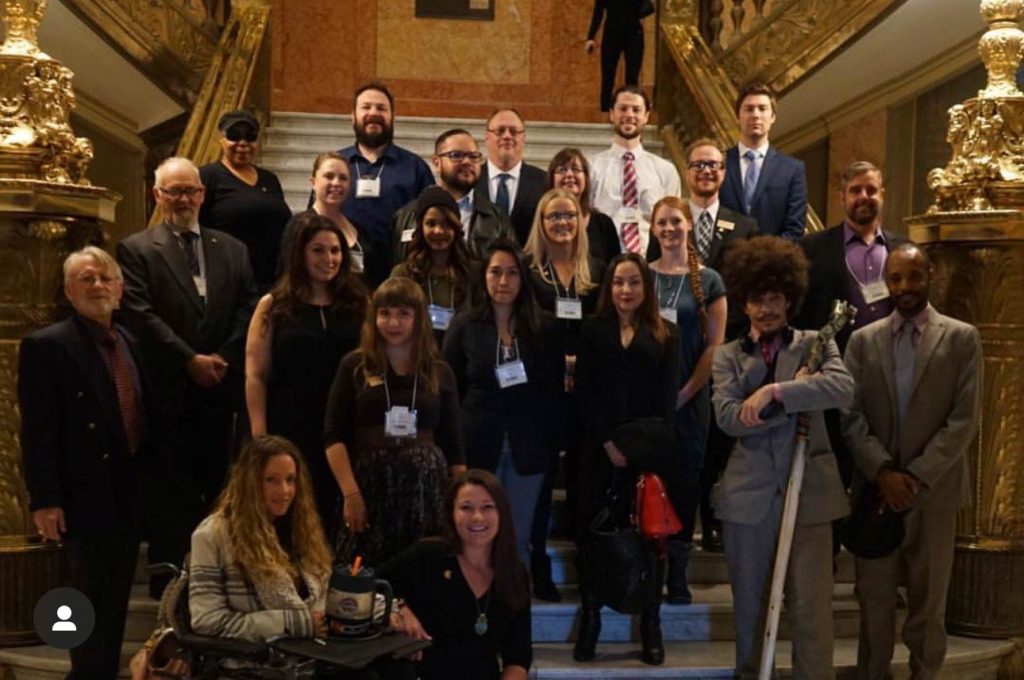Spreading harvested hemp in Kentucky, 1898 Unknown author – Popular Science Monthly Volume 54
Cannabis history in the U.S. is all but forgotten. Find out why, how, and when cannabis became illegal in America.
Cannabis history in America was once upon a time positive and progressive. Presidents and nationals freely grew, consumed, and explored cannabis. Laws and waitlists didn’t keep us from growing or consuming our favorite flower. Even state economic policies supported the plant’s use as a legal tender for market exchange.
So where have all these good times gone? Buried in thick history books and lengthy academic articles. This concise timeline of U.S. cannabis history details why, when, and how cannabis became illegal in America.
 Before The Cannabis War
Before The Cannabis War
No one knows when exactly cannabis came to America. What we do know is cannabis existed in the U.S. over 200 years before William O’Shaughnessy brought in the idea of medicinal cannabis. Unfortunately, when anti-cannabis proponents finally found the most questionable way to criminalize cannabis, they took it!
Cannabis was quite popular in the United States; but only for industrial and medical use of its extracts. However, just across the border, the Mexican people explored the plant recreationally and relished its soothing effects.
Then, the Mexican Revolution began. Thousands of Mexicans were forced out of their country into the U.S. in search of refuge, and along with them came their idea of the good plant.
Many Americans loved the cultural exchange, especially with the alcohol prohibition looming just ahead. However, some Americans were not very happy with the effects with the increased population; Henry J. Finger, a member of the California State Board of Pharmacy, actively belonged to this category. Severely displeased with the growing situation, Finger devised a “population control” strategy: criminalize cannabis, stigmatize the immigrants.
California Becomes The First State In Cannabis History
According to cannabis history records, California was the first state to make cannabis illegal, and Henry J. Finger was a major proponent of the cannabis illegalization movement in the state.
Years before the Mexican Revolution began, California was already grappling with anti-immigrant sentiments. Many individuals in the state, particularly Finger, did not like that the “Hindoos” (Finger’s term for East India immigrants of Sikh religion and Punjabi origin) were “initiating their Whites” into this habit”—referring to the recreational use of cannabis.
As a result, only two years after he’d written to Hamilton Wright, the Chief Architect of the U.S. Narcotics Policy, California illegalized “narcotic preparations of cannabis.” This action led to the end of medical cannabis use in the state for over 80 years and the start of statewide cannabis illegalization. Over 23 states followed suit between 1913 to 1931.
Various reports state that the Section 8A of the California law that illegalized cannabis use was a misinterpretation—or a legislature blunder. But seeing that this “blunder” wasn’t corrected immediately makes us question how much of a mistake it was.
Ultimately, multiple cannabis history records now clearly state that cannabis initially became illegal in the United States due to racial and political reasons and not because the authorities were concerned about the plant’s safety.
 The Decade Cannabis Changed
The Decade Cannabis Changed
From 1931 to 1941, cannabis faced its greatest challenges in the United States, and its loudest opponent was Harry J. Anslinger. As Commissioner of the Federal Bureau of Narcotics (FBN), Anslinger led the legal war against cannabis and played a pivotal role in the plant’s stigmatization.
According to multiple cannabis history records, the FBN Commissioner was actually going to attack the safety potential of the plant. But, when the scientists he sought gave him reports that “cannabis wasn’t dangerous,” he turned to character assassination and used the plant’s Mexican name, “Marihuana.”
In a recorded congressional testimony, Harry J. Anslinger claimed that marijuana caused violence and was used primarily among minority groups like Negroes, Hispanics, and entertainers. Anslinger tainted the word “Marijuana,” much like the War on Drugs tainted the word “safe” in the cannabis industry.
Harry J. Anslinger’s movement against cannabis led to Congress cracking down on the cannabis cultivation, sale, and use through the first cannabis bill in the United States: the Marihuana Tax Act of 1937.
Smack Right In The Middle
Silly but disappointingly true story. During World War II, hemp became a strategic resource needed by the Marines. But, very likely due to the recently passed Marihuana Tax Act of 1937, hemp was scarce in the country. Importation wasn’t even an option because their warring counterparts had cut off the country’s hemp supplies. As a result, the same government that had made it necessary to get a license before growing hemp but made it impossibly difficult to do so launched the “Hemp for Victory” campaign.
The “Hemp for Victory” campaign encouraged hemp cultivation in the country by sharing hemp seeds to willing farmers. It also granted draft deferments to all those willing to grow hemp to support war efforts.
Then, the war ended, and hemp reverted to its “difficult to grow legally” status.
Laws surrounding cannabis cultivation, use, and exploration remained tough until the seasons of Presidents Kennedy and Johnson. These two Presidents agreed with recurrently established scientific evidence—marijuana use did not lead to violence or heavier drug use. So, during their tenures, they worked to relax the penalties on cannabis-related offenses.
But, alas! This blissful cannabis season was not for long.
In 1969, Richard Nixon became President and reinstated the battle against cannabis through the Comprehensive Drug Abuse Prevention and Control Act of 1970. According to cannabis history records, Nixon enacted his federal rule against the recommendation of his appointed Chairman of the National Commission on Marihuana and Drug Abuse (the Shafer Commission).
The Comprehensive Drug Abuse Prevention and Control Act of 1970 led to the 1970 Controlled Substances Act, also known as the CSA. The CSA was the legal background for the War on Drugs and classified cannabis (without differentiating between hemp and marijuana) as a Schedule 1 Drug.
 100 Years Later In Cannabis History
100 Years Later In Cannabis History
Cannabis is still not federally legal in the U.S.A., but federal authorities have granted hemp a slight reprieve. In 2014, the Farm Bill under the USDA permitted small-scale expansion of hemp cultivation for pilot research programs. Five years later, the 2018 Farm Bill allowed hemp cultivation broadly, permitting hemp cultivation for commercial and other purposes, but with the following restrictions:
- Hemp must not contain over 0.3 percent THC per section 10113 of the Farm Bill.
- Hemp growers and producers must comply with federal and state regulations.
- Specific actions are considered violations of federal hemp law and activities that qualify as felonies.
Ultimately, this means hemp is legal in the United States, but not under a system that makes it as legal as other plants/crops like tomatoes or potatoes.
Meanwhile, cannabis has been gaining statewide momentum. Despite cannabis, otherwise called marijuana, being federally illegal in the U.S.A still, states are starting to release pro-cannabis regulations.
For instance, in 1996, California turned over and became the first state in the U.S. to legalize medical cannabis use in the country. Since then, over 40 U.S. states have legalized medical cannabis use, including Alabama. While over 20 states in the U.S. have decriminalized simple marijuana possession or legalized recreational cannabis use, otherwise called Adult-Use.
Blunt Tip: Marijuana decriminalization involves reducing or eliminating the crime of simple cannabis possession. Marijuana decriminalization is not the same as marijuana legalization.
This Day In U.S. Cannabis History
In 2022, President Joe Biden outlined three actions to “address the historical wrongs of marijuana prohibition.”
First, the U.S. president announced an unconditional pardon for all individuals convicted of simple marijuana possession under federal law stating,
“Sending people to prison for possessing marijuana has upended too many lives and incarcerated people for conducts that many states no longer prohibit. Criminal records for marijuana possession have also imposed needless barriers to employment, housing, and educational opportunities. And while white and Black and brown people use marijuana at similar rates, Black and brown people have been arrested, prosecuted, and convicted at disproportionate rates.”
Second, because the President does not have the authority to make state decisions, Biden encouraged all state governors to pardon all state-level offenses of simple marijuana possession. Finally, the President asked the Secretary of Health and Human Services (HHS) and the Attorney General to re-evaluate marijuana’s current federal schedule. A reschedule or deschedule could ultimately lead to Biden finally legalizing cannabis.
Besides these, there were no mentions of the lack of access to banking or capital cannabis producers or the multiple barriers to well-intentioned social equity programs for cannabis-related businesses. What would this mean for cannabis businesses in the event of a reschedule or deschedule?
Also, in December 2022, less than three months after Biden’s federal pardon, the President signed into law the first independent federal cannabis reform law in U.S. history —The Marijuana and Cannabidiol Research Expansion Act. This Act provides federal support for cannabis research and the potential health benefits of the plant.
However, cannabis is still not legal in the United States of America on the federal level, and the plant is yet to be decriminalized in the U.S. Nonetheless, polls show over 60% of Americans agree cannabis should at least be descheduled or reclassified from its current Schedule 1 status.
Furthermore, according to many proponents of cannabis decriminalization, decriminalizing cannabis would reduce the cost of maintaining the criminal justice and law enforcement systems. While legalizing cannabis in the U.S. would help the country’s economic system by raising domestic revenue.
But, would these arguments and gathering mainstream pro-cannabis support finally push federal decriminalization and legalization of the centuries-old plant? We can only wait to see.






